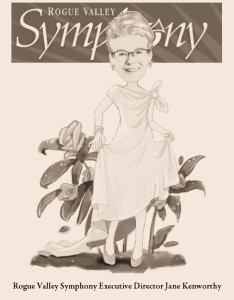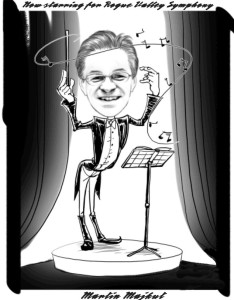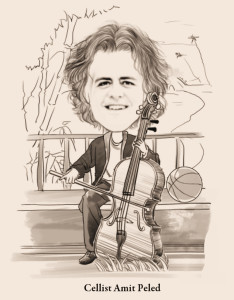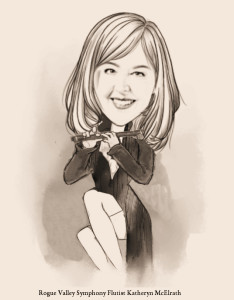RVS 2015-2016 Masterworks 2 Concert
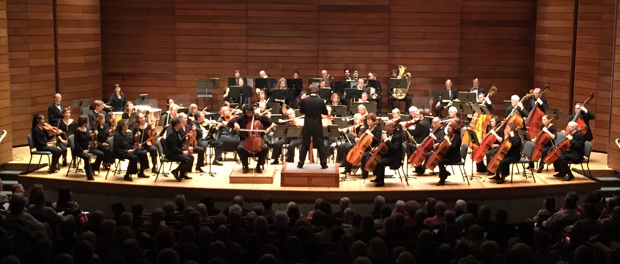 Cello Soloist Amit Peled, with Rogue Valley Symphony directed by Martin Majkut, perform Dvořák’s Cello Concerto in B minor during 2015-16 Season Masterworks 2 Concert on Oct. 16, 2015 at S.O.U. Music Recital Hall in Ashland, OR
Cello Soloist Amit Peled, with Rogue Valley Symphony directed by Martin Majkut, perform Dvořák’s Cello Concerto in B minor during 2015-16 Season Masterworks 2 Concert on Oct. 16, 2015 at S.O.U. Music Recital Hall in Ashland, OR
Rogue Valley Symphony’s Masterworks 2 Concert: Now Even Outperforming Major Metropolitan Orchestras
– by Lee Greene
After I published an effusive review of Rogue Valley Symphony’s 2015-16 Masterworks 1 Concert (http://performingarts.reviews/2015/09/27/rvs-2015-2016-masterworks-1-concert/), I received a note from the Symphony’s Executive Director, the tireless, hard-working Jane Kenworthy:
“Thank you for this review. . . . The only problem is — how do we ever keep up the standard of your praise?”
I replied:
“That’s the thing: [Music Director] Martin [Majkut] always seems to find a way; however good it may be, he’s always looking for and finding a way to improve; always pushing the level up another notch. He is amazing – an incomparable, unique & perhaps irreplaceable asset.”
While that may indeed be true, Rogue Valley Symphony Music Director Martin Majkut is never satisfied with what has already been done, and is always looking for ways to improve the next program. But I had inadvertently and egregiously overlooked Ms. Kenworthy’s invaluable contribution to the incomparable programs being presented by the Symphony, both in that reply, and in my earlier reviews. I shall not be making THAT mistake again, beginning with THIS review of Rogue Valley Symphony’s latest program: the 2015-16 Masterworks 2 Concert.
By now, it should come as no surprise to anyone that the Symphony’s second concert of the current season, Masterworks 2, certainly equaled, if not exceeded the superlative standard established by the organization’s recent previous programs. Once again, Maestro Majkut assembled a notable selection of pieces for the program, and had the symphony’s musicians playing at the top of their game. I dare say, unbelievable as it may sound, Dr. Majkut had this modest regional symphony outperforming some of the major symphonies of this country’s metropolitan areas (I mean it and I’ll explain later). But perhaps the most valuable contribution to this concert’s program came from Ms. Kenworthy. You see, what really made this program unforgettable was the performance of incomparable cello soloist, Amit Peled, who performed Dvořák’s Cello Concerto in B minor with the Rogue Valley Symphony on this program. It was the absolute best performance of a Dvořák composition I have ever heard and THAT is saying a lot. Well, it’s Ms. Kenworthy who has the wherewithal to, and does, find most of the soloists who perform with the Rogue Valley Symphony. It was she who selected Mr. Peled to perform at this concert and made the arrangements to make it happen. Maestro Majkut certainly did his part to make this an outstanding and memorable program. But without cellist Amit Peled, and Ms. Kenworthy’s effective efforts to get him here, it would certainly not have been the impressive concert that it was. Ms. Kenworthy, after Masterworks 2: “I done good, didn’t I [to get Mr. Peled as the soloist for this program]?” Yes, you absolutely, undeniably, categorically did! Talk about “an incomparable, unique & perhaps irreplaceable asset” to the Symphony; Dr. Majkut does NOT stand alone in that category.
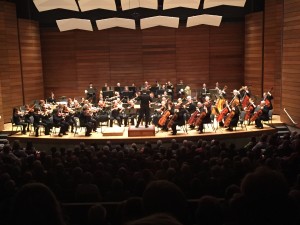
Rogue Valley Symphony directed by Martin Majkut, perform Smetana’s “Overture to the Bartered Bride” during 2015-16 Season Masterworks 2 Concert on Oct. 16, 2015 at S.O.U. Music Recital Hall in Ashland, OR
Now about the concert, which I saw on Friday, October 16, at the S.O.U. Music Recital Hall in Ashland (it was repeated on Sat., Oct. 17 at the Craterian Theatre in Medford, and again on Sun., Oct. 18 at the Grants Pass Performing Arts Center). As has been his habit. Dr. Majkut selected a short, challenging, very apt little masterpiece of a composition to begin the concert, Smetana’s Overture to the Bartered Bride. Czech composer Smetana is considered the father of Czech opera. “The overture, often played as a concert piece independently from the opera, was, unusually, composed before almost any of the other music had been written.” [Wikipedia, The Bartered Bride, https://en.wikipedia.org/wiki/The_Bartered_Bride] The overture “does not contain much of the musical material of the rest of the opera. What it certainly does do is to set the mood of the work with its brilliant dance figures and syncopations. . . . The overture stands alone as one of the great works for symphony orchestra.” [Rogue Valley Symphony Program Notes, Bedřich Smetana: Overture to the Bartered Bride (Prodaná nev sta), Mark E. Jacobs]
Dr. Majkut very effectively used the short but great work to set the mood for this concert program. The beautiful but hardly simple and easy piece was played flawlessly by the Rogue Valley Symphony under Dr. Majkut’s skilled direction. The work features very beautiful flowing string passages, of gradually increasing intensity and velocity, exquisite flute and piccolo solos, and some very prominent tympani contributions, all lovely in their own right, but telegraphing even better things to come later in the program. I’ve noted before that it seems like Dr. Majkut uses the introductory piece to warm up both the orchestra and the audience for the daunting and impressive things he’s placed later in the program, and the Smetana served that purpose well in this concert.
The second work on the concert program was the Dvořák’s Cello Concerto in B minor with Israeli-American cello soloist Amit Peled joining the symphony, which I have already gushed about in my comments above. Mr. Peled is perhaps the finest cellist in the world today. [No citations; my own humble but I believe accurate estimation.] He is renowned for the fact that he plays the instrument that belonged to the late Pablo Casals, who few people would dispute was the finest cellist of his generation: a Matteo Gofriller cello made around 1700.
Mr. Peled recently completed a world tour with the historic instrument, which was presented to him by Casal’s widow, including a 20 cities U.S. tour culminating in an acclaimed performance at the Kennedy Center in Washington. He has played with many of the world’s major orchestras and in just about all of the world’s major concert halls that are worth playing in. Reviewing a 2010 concert performance by Mr. Peled in Alice Tully Hall, reviewer Allan Kozin of The New York Times wrote of his “warm, glowing tone” and “seductive timbre and an emotionally pointed approach to phrasing that made you want to hear him again. . . .” [Allan Kozin, An Ensemble Sheds a Spotlight on New and Unusual Repertory, The New York Times, Nov. 7, 2010, http://www.nytimes.com/2010/11/08/arts/music/08riverside.html?_r=0]
Dvořák’s Cello Concerto in B minor is a very romantic, operatic work, scored for a full romantic orchestra, flavored with a tinge of tragedy. [Wikipedia, Cello Concerto (Dvořák), https://en.wikipedia.org/wiki/Cello_Concerto_%28Dvo%C5%99%C3%A1k%29] Dvořák had written the third movement for his sister-in-law (who he also happened to be madly in love with), incorporating in it her favorite work of his, his series of songs, The Cypresses. [Id.] But when Dvořák arrived at her sick room to show it to her, he found her recently deceased, throwing him into emotional turmoil, causing him to tear up the original manuscript and to rewrite the movement expressing his profound emotions. [A story Mr. Peled retold in his pre-concert remarks.] At one point in the piece there is a beautiful interplay between the cello, i.e. as Dvořák, and the concertmaster’s violin, taking the part of the sister-in-law. The performance of Dvořák’s Cello Concerto was indeed the best performance of a Dvořák work I have EVER heard, and that encompasses a lot of years worth of fine orchestras, notable conductors, eminent soloists and a variety of Dvořák works. Mr. Peled is a revelation. He plays with eyes closed, swaying his head, with majestic flourishes of his bow hand, very energetic, very emotional. The sounds coming from that Casals cello were unbelievable, absolutely gorgeous tones, extraordinary sublime vibrato, and rich low bass tones beyond what one might expect a cello to be able to produce. Though some might jump to the conclusion that those beautiful cello sounds are the product of that historic Casals instrument, Mr. Peled put things in proper perspective in his pre-concert remarks when he told an apocryphal Jascha Heifetz story:
“After a concert, a member of the audience went up to Jascha Heifetz. He said, ‘Wow, your violin sounds really great.’ Heifetz then held the violin up close to his ear and replied, ‘Funny, I don’t hear anything.’” [Violinist.com, Famous Quotes, http://www.violinist.com/discussion/response.cfm?ID=6268]
The well-taken point being that the instrument makes no sounds by itself, but it is the musician who must coax the beautiful sounds from it (and not something uglier that a lesser player might get from it).
Mr. Peled gave an impressive, extraordinary performance. BUT, he was not alone in delivering this beautiful concerto – the whole orchestra again worked at the top of their form and delivered magnificent performances. Concertmaster Scott Cole was masterful during his interplay with Mr. Peled as the violin representation of Dvořák’s love interest. Even better were some passages of interplay between Mr. Peled’s cello and the flute, played by Rogue Valley Symphony principal flutist Katheryn McElrath. There were some impressive parts by tympani (principal timpanist Theresa McCoy), by oboe (principal oboist Irene Fitch), by horn (principal horn player Jennifer Carstensen), and much of the string, wind, and brass sections.
Not surprisingly, at the conclusion of the Dvořák’s Cello Concerto the audience was unrestrained in its applause and appreciation, requiring multiple curtain calls and bows by Mr. Peled and Dr. Majkut. After it became obvious that this wouldn’t cease until an encore was offered, Mr. Peled stepped back on stage with his famous instrument, sat down and provided a jaw dropping, impossibly beautiful and moving performance of Ernest Bloch’s cello composition, Prayer – From Jewish Life. Again Mr. Peled’s cello playing was extraordinarily impressive. I shall probably never forget sitting in that hall, listening to Mr. Peled playing that encore piece, and thinking, being quite certain, that I was hearing that cello weeping!
Following an intermission, the orchestra returned to the stage to perform the most substantial piece on the program, Ludwig van Beethoven’s Symphony No. 6 (the Pastoral Symphony). Yes, believe it or not, there was more after the Dvořák, and it wasn’t an afterthought, it was the main piece on the program. Beethoven composed the work simultaneously with his more famous and rousing Fifth Symphony (Ta, ta, ta, TAH!). Well, the Sixth Symphony wasn’t an afterthought for Beethoven either – it’s a major, slavishly created, detailed, five movement programmatic work. “Beethoven was a lover of nature who spent a great deal of his time on walks in the country.” [Wikipedia, Symphony No. 6 (Beethoven), https://en.wikipedia.org/wiki/Symphony_No._6_%28Beethoven%29] Beethoven’s Pastoral Symphony is an explicitly, detailed programmatic work, depicting an excursion in the countryside. [Id.] Beethoven described his Sixth Symphony this way: “Pastoral Symphony, more an expression of feeling than painting. 1st piece: pleasant feelings which awaken in men on arriving in the countryside. 2nd piece: scene by the brook. 3rd piece: merry gathering of country people, interrupted by 4th piece: thunder and storm, into which breaks 5th piece: salutary feelings combined with thanks to the Deity.”
Though the Sixth Symphony isn’t as fiery as its companion work, the Fifth Symphony, it isn’t really simple and easy to perform, perhaps even more of a challenge. Among other things, Beethoven included metronome markings for this symphony which are quite fast and rather daunting. Consequently, most conductors, even the most eminent at the most prestigious orchestras, tend to ignore them, describing them as “absurdly fast and possibly wrong”, preferring to believe that Beethoven’s metronome was “broken.” [Smithsonian Magazine, Was Beethoven’s Metronome Wrong?, http://www.smithsonianmag.com/smart-news/was-beethovens-metronome-wrong-9140958/?no-ist] For many orchestras and conductors, it’s just too impossibly difficult to follow Beethoven’s fast tempo markings. Well, NOT for Maestro Martin Majkut directing Rogue Valley Symphony. Bucking the trend among conductors to ignore Beethoven’s metronome markings and slow the piece down, Maestro Majkut prepared the orchestra to play the piece as Beethoven instructs, at the fast tempos he has marked. And so they did. Flawlessly, gloriously, magnificently, unbent or tarnished by the fast tempos, it was a stunning performance. It’s really a shame if you missed it, but I CAN offer you a two minute excerpt so you can hear a bit for yourself:
Beethoven was a master at using an orchestra well. The Pastoral Symphony is scored for 14 wind and brass instruments, timpani, and a full complement of strings, and they all have substantial parts to play in this piece. Dr. Majkut had them all performing exceptionally, at Beethoven’s prescribed “absurdly fast” tempos. That’s what I meant when I said “Dr. Majkut had this modest regional symphony outperforming some of the major symphonies of this country’s metropolitan areas.”
I fully well expect Dr. Majkut, Ms. Kenworthy and the Rogue Valley Symphony to keep up this unsurpassed standard of excellence at their next series of Masterworks concerts, the 2015-16 Masterworks 3 Concert, featuring acclaimed violinist, Elena Urioste, performing Beethoven’s Violin Concerto, and the Symphony performing Mozart’s Symphony No. 38 “Prague”, as well as premiering a new commissioned work, Theofanidis’s Dreamtime Ancestors. Performances are scheduled on January 15, 2016 at S.O.U. Music Recital Hall in Ashland, January 16 at the Craterian Theatre in Medford, and January 17 at Grants Pass Performing Arts Center. Tickets can be obtained by calling 541-552-6398 or online at http://bit.ly/1W5AS5g.
